
Day one in Turkey
Heading out, I resist the nice Java Studio coffee shop on the corner, and a few steps later am in front of the magnificent Blue Mosque, aka Sultan Ahmed Mosque.

It was built between 1609 and 1616 (7 years!) during the reign of Ahmed I, who wanted to placate Allah after losing several battles – having lost he had no spoils to use and so took treasury cash to build the place. Passing benches outside, one enters an inner courtyard through tall doors to the right-hand side of the mosque,

where the main entrance can be found, along with piles of snow on the side receiving less sun.
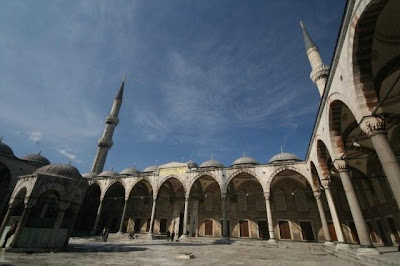
No charge for entry (today perhaps – there is a ticket-booth style construct, with books of tickets), but one takes shoes off (as with all mosques) and places them in a plastic bag which you keep with you.

Inside is a huge chamber, topped by multiple intersecting domes, more than 200 stained-glass windows and beautiful floral tiling.

The upper levels are painted blue, hence Blue Mosque.

The design apparently is a blend of Byzantine and Ottoman, drawing on elements from the Byzantine-era Hagia Sophia that it faces.

One of the enormous support columns
A couple of interesting facts – apparently the Sultan was criticised for building the mosque with six minarets (the towers outside the mosque) – this was the same number as the Ka’aba Mosque in Mecca. He solved this by paying for the construction of another minaret in Mecca! Other funny one – the chandeliers hold ostrich eggs that are there to repel spiders and hence prevent cobwebs inside the mosque! Top tip!


Hippodrome
Next to the Blue Mosque is the Hippodrome, a garden square which was originally a horse-racing track in Byzantine times, when the city was named Constantinople. The hippodrome was first built by Emperor Septimius Severus in AD324. There used to be a copper statue of four horses here which was pinched in the fourth crusade in 1204 and hauled off to Venice for St. Mark’s Basilica. I’ll check this out next week when I’m there!
Unfortunately not much remains today of the original splendour. There is however the Serpent Column, a copper spiral like snakes braided together, cast to celebrate victory over the Persians by the Greeks in 5th century BC. It used to be topped by a golden bowl held by three serpents’ heads, but that’s long gone. Then an obelisk from the Temple of Karnak in Luxor, Egypt dating from 1490BC, brought here in 390.

Would you believe this is 3,500 years old? How do you think the Diana Memorial will age?!
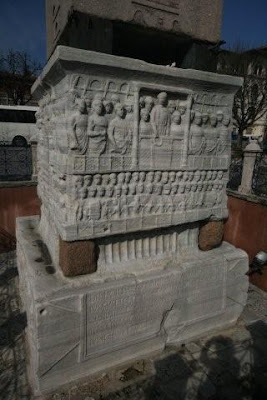
The base
At the far end is the Walled Obelisk, which was originally covered by bronze.

Without the plaques, it looks like a medieval game of Jenga!
The Hagia Sophia
Next up, the Hagia Sophia, facing the Blue Mosque over a park with a fountain.

Google Earth:41_00_54_N_28_58_38_E. It was one of the runners up for Seven Wonders of the World (tick, hehe!), and so it should be for a steep 10L entry fee. I think I read somewhere this church was the inspiration for various buildings in Naboo in Star Wars Episode I, and has appeared in SimCity. It’s famous for its enormous dome,
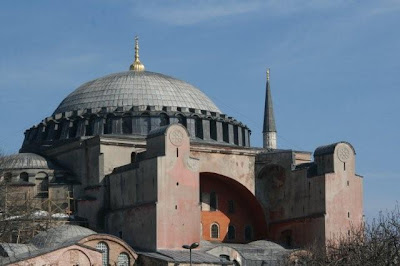
for its minarets (when the Ottomans captured Istanbul in 1453 they converted it to a mosque) and for being the largest church in the world for over 1,000 years, until the medieval construction of Seville Cathedral in 1520. It’s now a museum, converted in 1935 by secular Turkey.

It sits on top of two previous churches,

Limited excavations of the remains of the previous churches
and in fact itself has had a fair few problems over the years – the dome has needed repairing or collapsed entirely several times through earthquakes and fires.

Structural supports and buttresses have been added to the building over time, especially by the Ottoman architect Sinan, considered the first Earthquake engineer. Originally constructed between 532 and 537AD by over 10,000 workers under the orders of Emperor Justinian, and is considered the height of Byzantine architecture.

When converted into a mosque they plastered over the mosaics. As the principle mosque of Istanbul, it was the inspiration for many of the others, like the Blue Mosque and Suleymaniye.

Inside, one enters into a huge nave, above which, over 55m up is the enormous dome, 31.24m in diameter.

Looking up
Around its base are 40 arched windows, which create the effect of the dome seeming to float on top of the church.

Someone’s having a revelation!
In the corners of the nave, which has scaffolding up for renovation, are large wooden disks with calligraphic versions of the names of Allah, Mohammed and his relatives plus other Islamic bigwigs.


Good job they didn’t put a picture of his face up, eh? A painting of his name, that’s okay though. I’m glad religions are so logical.

The Hagia Sophia is also well-known for its beautiful mosaics, which over the years have been stolen, plastered over, burnt etc. Those that are left are beautiful. When Constantinople was sacked in 1204, the Doge of Venice who organised it shipped lots of artefacts and mosaics back there.


Some of which are displayed on photo boards as they are in inaccessible places or are being restored:


After touring the upper gallery, I loop round the ground floor.

Marble jar from Pergamon, carved from single block of marble
Apparently the construction used lots of mortar rather than brick, and the builders didn’t wait for it to dry before building on top of it, greatly weakening the structure. When the dome was placed on top, the walls bent outwards!

The stele of St. Gregory Thaumaturgus, which has miraculous powers!

The Islamic version of the pulpit

Overall, a marvellous experience, and unlike many attractions in Istanbul, just as interesting on the inside as the outside, if not more so!

Hagia Sophia from Beyoglu side
Sirkeci Station and the Galata Tower

I follow the tram lines down to Sirkeci Station, the main train terminus on the European side of Istabul, where I buy my ticket for Athens at the international ticket window. Except the chap behind the window won’t sell me a ticket to Athens, only to Thessaloniki, where I’ll have to buy the onward ticket. He’s very brusque in the way he fills out the several tickets and forms that procedure dictates are completed – you can see he’s done this a few times before, and has no intention of spending a second longer than necessary dealing with me. I had over 89L via credit card, and as soon as he’s passed my ticket to me he wanders off, somewhat annoyingly as I have questions for him, for example can he explain what he’s written on the ticket – his handwriting is completely illegible. The station itself is not especially exciting, despite being the terminus of Orient Express trains from Western Europe – there is a historic restaurant at the edge of platform 1, and a small museum which unfortunately doesn’t have much English labelling.

Across the Galata Bridge, passing crowds of people fishing,

all apparently pulling out tiny fish, to the Galata Tower, reached after a short steep climb on the Beyoglu side.

The tower is a 66.9m stone cylinder, with a 10L entry fee, which gets you a lift ride up to the top where there is a observation deck which stretches around the outside.

To be honest, it’s definitely not worth 10L for a view which is not dissimilar to that which you have around the area anyway, I wouldn’t recommend it.

Amusingly, it was used in Ottoman times as a lookout for spotting fires, before it burnt down itself. Down via the usual tat shops that such attractions always include.
Istanbul Modern and Java Studio

Around the bay in the direction of Dolmabahce Palace I reach Istanbul Modern, a converted warehouse which today is free entry, saving me 7L, woo! It covers two floors, the upper of which hosts the permanent exhibitions, including lots of works from Turkish painters, and pleasingly a large portion of classic work too. No photography though. Downstairs is of less interest to me – some photography and “very modern” stuff! Anyway, I’d recommend the place solely on the basis of their permanent collection. There’s also a café which looked nice.

Tram back, 1.30L which is the fixed fare, paid for at the small booth which most tram stops seem to have. The trams here are quick, efficient and cheap, albeit with limited routes. Today I decide to stay on past my stop of Sultanahmed to look for a bookshop. I wait a few more stations then get off and walk back through the shopping districts that this area seems to comprise. Unfortunately, not a single bookshop, just clothes everywhere – principally jeans. Why so many denim shops, doesn’t seem to make sense! I later discover that I had been very close to the Book Market, which is just past the Grand Bazaar, but my need went away when I discovered the Collective Plays of Oscar Wilde in the book exchange at my hostel!

Sun setting..
I pop into Java Studio, who have really friendly staff, and find that they have lots of guidebooks I can browse with my well-made cappuccino, including TimeOut Istanbul and LP Greece. Very useful for research! I meet the very smiley and well-travelled Kaori, who is also staying in the Antique Hostel, but is unfortunately off to Ephesus tonight, so I end up dining alone at Bukhara, about a ten minute walk away, recommended by TimeOut. As soon as I sit down, I realise I’m surrounded by middle-aged middle-class English people – the perils of relying on a guide book!

There’s a table of eight teachers across from me, discussing their piano lessons, students the waiters apparently resemble and the awful time they had in a backpacker place once. Anyway, I order a acih kebap (spicy kebab) for 12L,

a Buhara Pilavi 4L
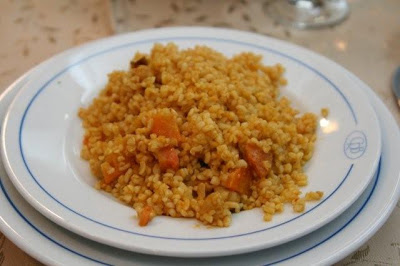
and a large Efes beer (8L). As you can see, Istanbul is not cheap! 24L plus coffee and service for dinner in a recommended place! Smoking is also fairly prevalent, as someone behind me lights up just as my food arrives. At least the food is good!


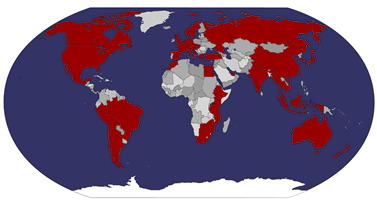


No comments:
Post a Comment